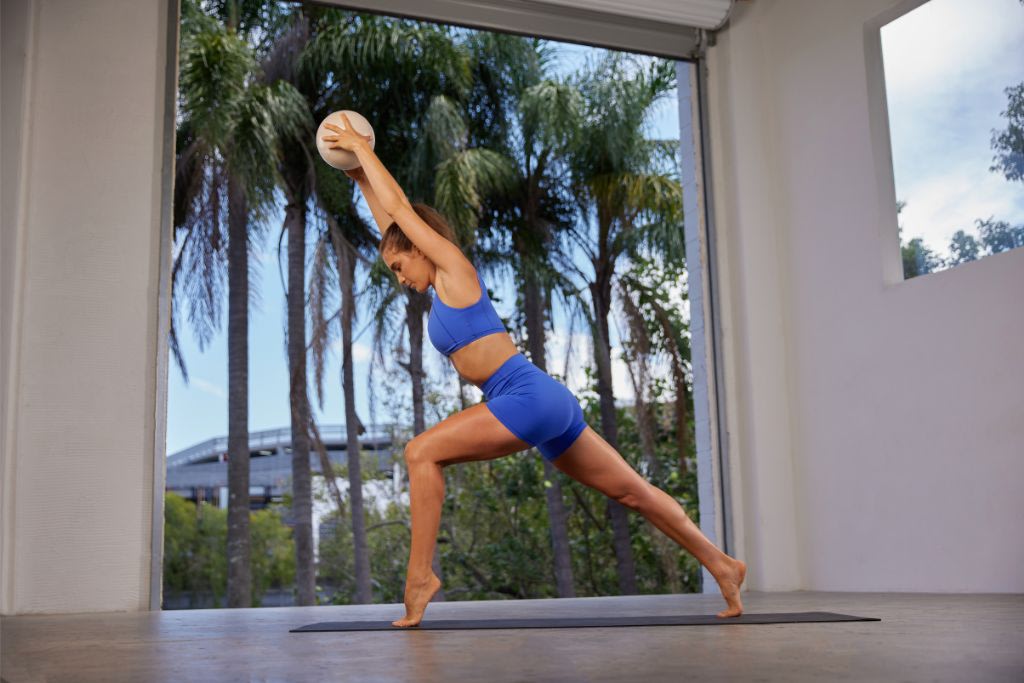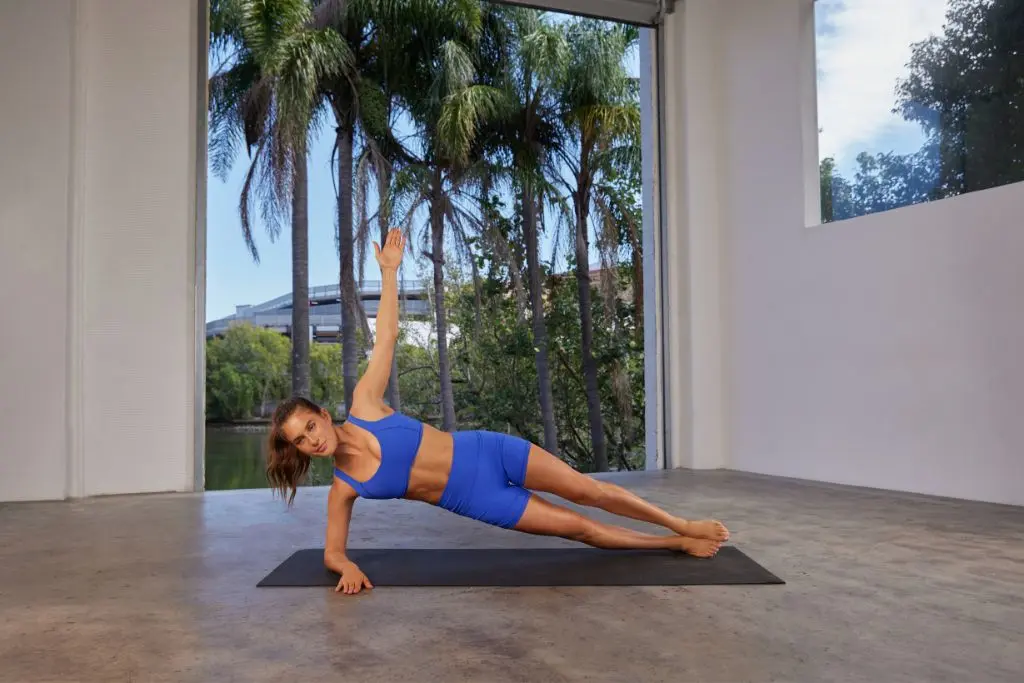Discover The Benefits Of Pilates: Strength, Flexibility, Balance & More

May 17, 2021 - Updated February 21, 2024

If you’re after a training style that’s low in intensity, can be practiced anywhere and that’s jam-packed with benefits, you might want to give Pilates a go. Don’t underestimate the impact this whole body workout can have.
Whether you choose Pilates as your main training program or do the occasional class to complement and support your existing training, a Pilates practice promotes everything from increased flexibility to core strength and improved alignment.
What is Pilates?
Founded by German-born gymnast Joseph Pilates in 1926, Pilates is a low-impact workout that was rooted in rehabilitation and building strength. Pilates sessions focus on stretching, strengthening, breath work, and properly aligning the body through slow and controlled movements that target core strength, flexibility and alignment.
A typical class will involve a series of simple, repetitive, exercises with an emphasis on muscular exertion in the abdominals, lower back, hips, thighs and glutes. These smaller movements require you to stabilise your core and back to complete the exercises with correct form.
The benefits of Pilates
Pilates strengthens your whole body
A typical Pilates workout will activate the core muscles that support your spine, such as your abs and obliques. As Cleveland Clinic points out: what happens in your core affects the rest of your body. Over time, this core activation will strengthen the muscles in your back, core and hips, leading to a stronger, more supple spine, and better pelvis and hip alignment.
A 2015 Netherlands study that assessed the effectiveness of 12 weeks of Pilates on muscular strength on a group of post-menopausal women, confirmed that Pilates increased abdominal, upper, and lower body muscle strength.
The benefits don’t stop there. As Harvard Health highlights, a stronger spine and core can help improve your ability to perform everyday movements, as well as promoting good balance, stability and posture. The stronger your core, the easier it is for your body to activate and train the right muscles so that other muscles don’t end up over-compensating.
Pilates can be done anywhere
While there are certainly Pilates practices (reformer, anyone?) that require fancy equipment or a studio membership, Pilates can also be practiced on a mat, meaning you can get in a workout almost anywhere. The Pilates programs and on-demand workouts in the Sweat app require a mat and occasionally some pieces of at-home equipment, making this an accessible training style.
Pilates increases flexibility and mobility
Pilates is renowned for its ability to improve flexibility, with studies supporting these findings.
As your mobility and flexibility improves, you may also find you’re able to reach further, jump higher and squat deeper in your other workouts. A benefit of flexibility is an increased range of motion around the joints, and muscles that are well-stretched can more easily reach a full range of motion.
Pilates also helps to create a greater range of motion. This can be especially beneficial to those who run, swim or dance, as a higher range of motion in the hip joints can improve stride length and technique.

Pilates improves balance
Having good balance means you can control your body’s position whether you’re moving slowly or quickly. Improved balance stems from better control of your movements, which comes from having a strong core and flexible muscles – two things a regular Pilates routine will absolutely help you build.
A 2007 study found that adults who’d completed 10 Pilates-based exercise sessions showed a significant change in dynamic balance while doing a functional reach test.
Pilates improves posture
Pilates promotes good posture by helping to realign the body and spine. Sitting and standing with proper alignment plays an important role in improving blood flow and supporting your muscles, ligaments and tendons.
A 2016 study found that Pilates not only improves posture by enhancing body awareness, acknowledging that it can also be beneficial to those with specific postural misalignments.
Pilates may help improve existing back pain
A 2016 review on the effects of Pilates on patients with chronic non-specific low back pain found that Pilates showed significant improvement in pain relief and functional enhancement. Alongside yoga, Pilates is also recommended by Mayo Clinic as a way to prevent back pain due to the way it helps to facilitate core strength.
Pilates may improve your mood
The benefits of regular exercise on our mental health are well documented, and Pilates is no exception. Beyond the obvious impact of finding a training style that makes you feel-good, the breathwork component of a Pilates class can do wonders for your mood.
Breathwork is one of the core components of a Pilates emphasised by Joseph Pilates himself, and psychological well-being has both been associated with slow, controlled breathing techniques in a 2018 study.
Pilates can help you get the most out of your other workouts
Whether you combine Pilates with other low-impact training styles such as yoga or swimming, or practice it alongside high-impact workouts like running or high-intensity interval training, you’ll find a regular Pilates routine will help you move closer to your overall fitness goals. This is because the benefits of Pilates – increased strength, improved posture, greater flexibility – all ladder up to improved full-body strength, helping you to squat deeper, reach further and jump higher.
Trainer Katie Martin includes a combination of Pilates, strength training, and running in her own routine.
“Whether your goals are running faster or longer distances or lifting heavier weights with your strength training, Pilates isn’t going to take away from your current training routine, it’s going to enhance it and make your body stronger and more capable,” she says.
Pilates can help reduce your risk of injury - and be used as part of a rehabilitation program
Joseph Pilates’ original methodology was largely born out of his work rehabilitating soldiers during World War 1, and Pilates has a long history of being utilised as a rehabilitation practice.
Today, many dancers use Pilates as a form of cross-training to help isolate, activate and strengthen muscles, helping to reduce their risk of injury from any muscular imbalances.
If the majority of your workouts tend to be high impact, you might want to consider using Pilates as an active recovery day workout or a way to balance out your routine. Katie Martin’s On Demand Pilates classes are a great place to start!
Pilates is suitable for everyone
No matter your age, fitness level, or access to equipment or space, Pilates can be modified to suit everyone – even if you’ve just started working out.
Ready to reap the benefits of Pilates?
Whether you’re a Pilates beginner or looking for a challenge, Sweat has a number of Pilates options on offer for you.
Alongside her On Demand Pilates classes, Katie Martin’s 12-week Strength & Pilates program is perfect if you want to include elements of Pilates in your strength training routine.
Trainer Sara Colquhoun also has two programs available. Pilates with Sara is a 16-week program that combines traditional and contemporary Pilates with elements of functional movement training to increase flexibility, core strength and improve full-body muscle definition. Looking to push yourself or start with a shorter goal? Her 3-week Core & Body Connection Challenge program will give you a full-body Pilates challenge with abs-focused classes.

A more empowered you starts with Sweat, and our editorial team is here to bring you the latest fitness tips, trainer recommendations, wellbeing news, nutritional advice, nourishing recipes and free workouts.
* Disclaimer: This blog post is not intended to replace the advice of a medical professional. The above information should not be used to diagnose, treat, or prevent any disease or medical condition. Please consult your doctor before making any changes to your diet, sleep methods, daily activity, or fitness routine. Sweat assumes no responsibility for any personal injury or damage sustained by any recommendations, opinions, or advice given in this article.
Fitness